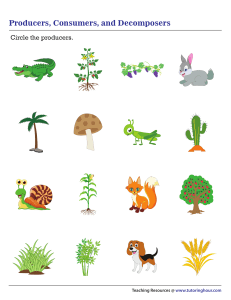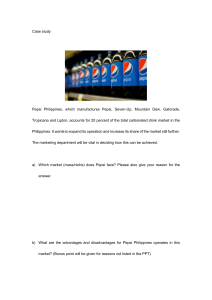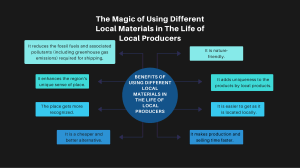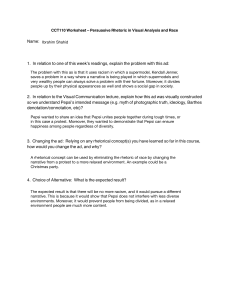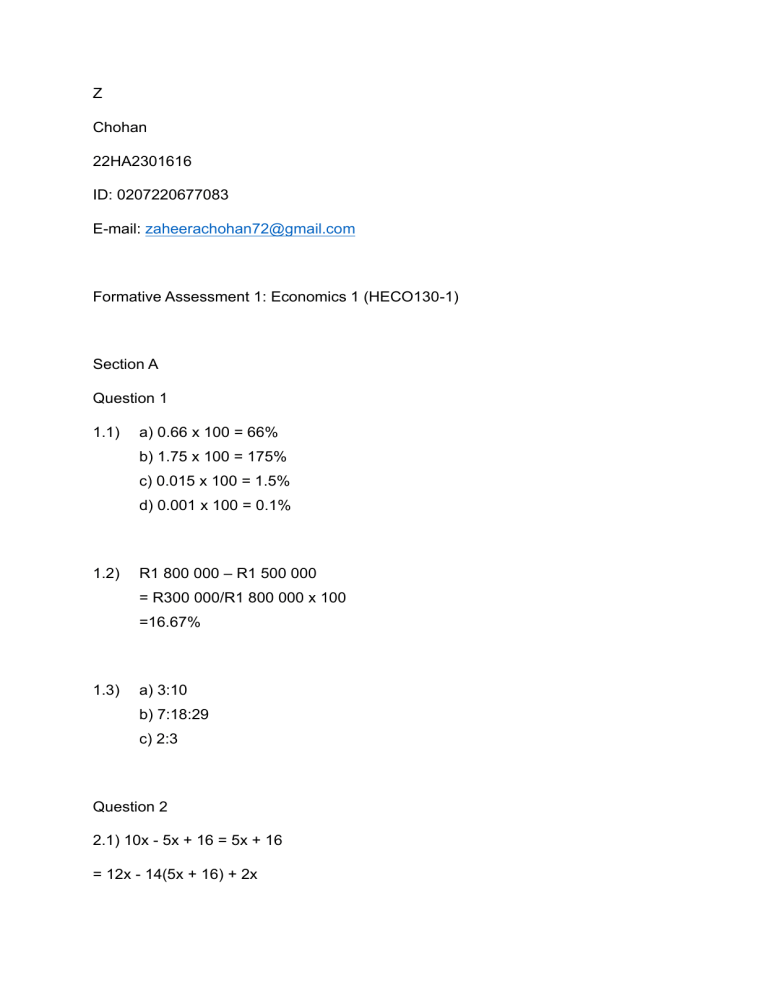
Z Chohan 22HA2301616 ID: 0207220677083 E-mail: zaheerachohan72@gmail.com Formative Assessment 1: Economics 1 (HECO130-1) Section A Question 1 1.1) a) 0.66 x 100 = 66% b) 1.75 x 100 = 175% c) 0.015 x 100 = 1.5% d) 0.001 x 100 = 0.1% 1.2) R1 800 000 – R1 500 000 = R300 000/R1 800 000 x 100 =16.67% 1.3) a) 3:10 b) 7:18:29 c) 2:3 Question 2 2.1) 10x - 5x + 16 = 5x + 16 = 12x - 14(5x + 16) + 2x = 12x - 70x - 224 + 2x = (12x + 2x) - 70x - 224 = (14x - 70x) - 224 = -56x – 224 2.2) 𝑥 + 5/9 - 5/9 = 1/9 - 5/9 𝑥 = -4/9 𝑥 + 5/9 = 3/27 is 𝑥 = -4/9 2.3) 𝑧 - 𝑥𝑢 = 24𝑣 (𝑧 - 𝑥𝑢) / 24 = 𝑣 𝑧 = 24𝑣 + 𝑥𝑢 can be changed to 𝑣 = (𝑧 - 𝑥𝑢) / 24. 2.4) 125/5 = 25 𝑥^6 / 𝑥^4 = 𝑥^(6-4) = 𝑥^2 𝑦^4 / 𝑦^2 = 𝑦^(4-2) = 𝑦^2 The simplified expression is 25𝑥^2𝑦^2. 2.5) Perimeter = 2(Length + Width) = 2(25cm + 10cm) = 2(35cm) Perimeter = 70cm Question 3 3.1) gradient = (y2 - y1) / (x2 - x1) = (3 - 12) / (2 - 8) = (-9) / (-6) =9/6 =3/2 3.2) MI = 24 * 50,550 MI = 1,213,200 The marginal income when 50,550 units of coal were sold is $1,213,200 3.3) Gross profit = Total revenue - Variable cost 8000 = Total revenue - Variable cost 8000 = 8Q - 2Q 8000 = 6Q Q = 8000 / 6 Q = 1333.33 Total revenue = 8Q = 8 * 1333.33 = 10666.64 = x% of total revenue = (x/100) * total revenue = (x/100) * 10666.64 Therefore, the settlement discount is (x/100) * 10666.64. 3.4) (2) for x: 6𝑥 − 10𝑦 = 24 6𝑥 = 10𝑦 + 24 𝑥 = (10𝑦 + 24)/6 12((10𝑦 + 24)/6) + 4𝑦 = 140 24𝑦 + 48 = 140 24𝑦 = 92 𝑦 = 92/24 𝑦 = 23/6 𝑥 = (10(23/6) + 24)/6 𝑥 = (230/6 + 24)/6 𝑥 = (230/6 + 144/6)/6 𝑥 = 374/6 𝑥 = 187/3 𝑥 = 187/3 and 𝑦 = 23/6. Question 4 4.1) Tracking stock prices, analyzing temperature changes, population growth 4.2) Number of restaurants in different categories according to google review over a period of two years, 2019 and 2020 45 40 35 30 25 20 15 10 5 0 1 star 2 star 3 star 2019 4 star 5 star 2020 Section B Question 5 5.1 Economics is a social science that studies how individuals, businesses, and society make decisions about the distribution of scarce resources. Examines how people make decisions to maximize happiness in the face of limited resources and unlimited desires. Economics analyzes various aspects of human behavior, such as the production, consumption, and distribution of goods and services. It also examines how markets work, the role of the state in the economy, and the influence of politics on individuals and society. Economics aims to understand and explain economic phenomena and provide insights for policy making through the use of mathematical models, statistical analysis, and empirical research. Overall, economics as a social science aims to understand and improve the functioning of the economy in order to enhance the well-being of society. 5.2) Opportunity Cost. 5.3) | United Kingdom | / | / | / | / | / | / | / | / | / |/ |/____________________ China Question 6 6.1) Resource allocation: Pricing acts as a signal to guide resource allocation. As demand for goods and services rises, their prices also rise, directing producers to allocate more resources to production. Conversely, when demand drops, prices drop, so you know you need to reallocate resources elsewhere. Distribution of scarce resources: In a free market economy, resources are finite and prices help ration these scarce resources. When demand exceeds supply, prices rise, encouraging consumers to consume less and allowing resources to go to those willing to pay higher prices. Incentives for production: Prices give producers an incentive to increase production. When prices are high, producers try to increase production to maximize profits. Conversely, when prices are low, producers can reduce production or switch to more profitable goods and services. Signal transduction: Price conveys information about the relative scarcity and value of a good or service. High prices indicate scarcity or high demand; low prices indicate abundance or low demand. This information helps consumers make informed decisions and helps producers make resource allocation decisions. efficiency: The price mechanism promotes efficiency by promoting competition among producers. When prices are determined by market forces, manufacturers are incentivized to minimize costs and improve quality to attract consumers. This competition fosters innovation, productivity, and overall economic efficiency. Flexibility: Prices in a free market economy are flexible and adapt to changes in supply and demand. When conditions change, prices react quickly, allowing the economy to adapt and allocate resources efficiently. Type of production factor Factors of production are the resources used to produce goods and services. There are mainly he four types of production factors. Country: This means all natural resources used in production, such as the land itself, minerals, water and other raw materials. Land is a passive element and contains no man-made inputs. work: This work involves the physical and mental effort of those involved in the production. This includes both physical and mental labor, such as: B. Workers' skills, knowledge, and abilities. capital: Capital refers to human resources used in production, such as machinery, equipment, buildings, and infrastructure. This includes both physical capital (such as tools) and financial capital (such as money). Entrepreneurship: Entrepreneurship involves organizing and coordinating other factors of production. Entrepreneurs take risks, innovate, and make decisions that combine land, labor, and capital to create goods and services. These factors of production are essential to economic activity and contribute to the production of goods and services in the economy. 6.2) Country: This means all natural resources used in production, such as land, water, minerals and forests. Land is essential for agriculture, mining and construction. Work: work is the physical and mental effort an individual makes in the production process. This includes both skilled and unskilled workers. Labor is essential to manufacturing, services, and all human-powered activities. capital: Capital refers to man-made resources used in production, such as machinery, equipment, buildings, and infrastructure. Capital is essential to increase productivity and efficiency in various industries. Entrepreneurship: Entrepreneurship refers to the ability to organize and control other factors of production. Entrepreneurs take risks, innovate, and make decisions to start and run a business. They play an important role in promoting economic growth and development. Question 7 7.1) Product price: The price of the product itself is an important factor that determines demand. In general, when the price of a product increases, the quantity demanded decreases and vice versa. income: Consumer income plays an important role in determining product demand. As income increases, consumers' purchasing power tends to increase, increasing demand for goods and services. Related product prices: The prices of related commodities, such as substitutes and complements, affect demand for a particular product. An increase in the price of a substitute product may increase the demand for the original product. Conversely, an increase in the price of the complementary product may reduce the demand for the original product. Consumer tastes and preferences: Consumer tastes and preferences also influence demand. If consumers develop a preference for a particular product or their preferences change, this can lead to an increase or decrease in demand. Consumer expectations: Consumer expectations about future prices, income, and other factors can affect current demand. For example, if consumers expect prices to rise in the future, they may increase current demand to avoid paying higher prices later. Population and Demographics: Population size and composition can affect demand. Changes in population size, age distribution and other demographic factors can affect demand for certain products. Advertising and promotion: Marketing activities such as advertising and promotions can affect consumer demand. Effective marketing campaigns increase product awareness, generate interest, and drive demand. 7.2) a) If Zack got a raise in his allowance, it would increase his purchasing power. As a result, Zack's demand curve for normal goods would shift to the right. This means that at any given price level, Zack would be willing and able to buy a larger quantity of goods than before. The shift indicates an increase in demand. b) If Debra substitutes Coke for Pepsi following a decrease in the price of Pepsi, it implies that Pepsi has become relatively cheaper compared to Coke. Since both products are normal goods, Debra's demand curve for Pepsi would shift to the right. This means that at any given price level, Debra would be willing and able to buy a larger quantity of Pepsi than before. The shift indicates an increase in demand for Pepsi. 7.3) A price ceiling is the highest price set by a government or regulatory authority. It is usually set below the market equilibrium price. The effects of price caps include: bottleneck: If the price ceiling is below the equilibrium price, there will be excess demand or shortage. Suppliers are unable or unwilling to supply the quantities demanded at artificially low prices, leading to shortages in the market. Black market: Price caps can create incentives for illegal activities, such as the creation of black markets. Sellers may sell their products/services on the black market at higher prices to take advantage of the excess demand. Quality deterioration: Suppliers may reduce the quality of their products or services to compensate for lower prices. This is because we have limited resources to maintain the same level of quality at a lower price. Allocation Inefficiency: Price caps can lead to inefficient resource allocation. By setting artificially low prices, people who do not appreciate the value of a product or service can be consumed by those willing to pay a higher price. floor price A floor price is the lowest price set by a government or regulatory authority. It is usually set above the market equilibrium price. The effects of the price floor included. Extra parts: An oversupply or surplus occurs when the floor price is above the equilibrium price. Suppliers try to supply more than demand at artificially high prices, leading to oversupply in the market. Reduction in consumer surplus: A price floor can lead to higher prices for consumers, thereby reducing consumer surplus. Consumers are forced to pay more for products and services than they are willing to pay, which can lead to a decline in their overall well-being. Inefficient resource allocation: Price floors can lead to inefficient resource allocation. Artificially high prices can cause products and services to be produced and provided even when there is limited demand for them. Reduced competition: Price floors can inhibit competition because suppliers may have less incentive to innovate or compete on price. This can reduce efficiency and slow market trends. Question 8 Section a: In this section, consumer purchasing behavior is characterized by high demand. Consumers are willing to pay higher prices for products and services, indicating relatively inelastic demand. This may be due to factors such as product necessity and limited inventory of substitutes. Consumers are more likely to buy a product even if the price goes up. Section b: Consumer buying behavior is still relatively prominent in this section, but not as intense as in Section A. Demand is moderately elastic, meaning consumers are sensitive to price changes. Lower prices make consumers more likely to buy more products and services. However, consumers may be willing to pay a higher price than Sections C and D. Section C: In this section, consumer purchasing behavior is more sensitive to price changes. Demand is relatively elastic, suggesting that consumers are highly sensitive to price changes. If prices go down, consumers are more likely to increase demand significantly. Conversely, if prices rise, consumers can reduce demand or look for alternatives. Section D: In this section, consumer purchasing behavior is highly sensitive to price changes. Demand is so elastic that even a small change in price can cause a large change in quantity demanded. Consumers are highly price sensitive and may switch to alternative products or stop buying a product altogether when prices rise.
